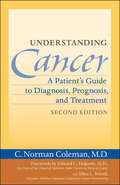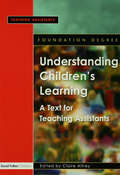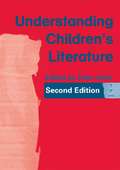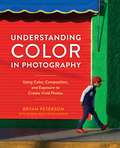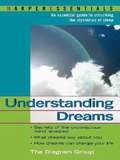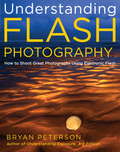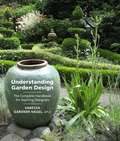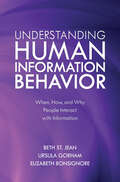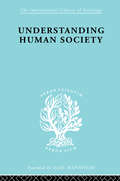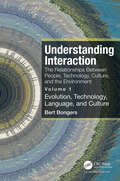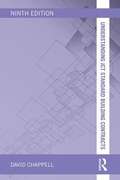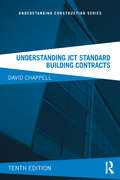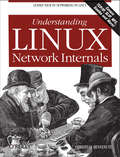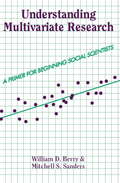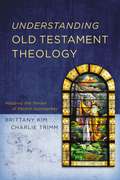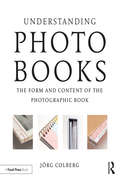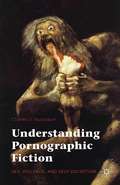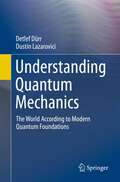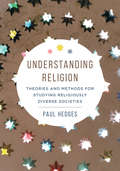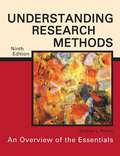- Table View
- List View
Understanding Cancer: A Patient's Guide to Diagnosis, Prognosis, and Treatment
by C. Norman ColemanThe greatest need of anyone with cancer is to understand the disease—its diagnosis, treatment options, and the often devastating experience of having cancer. In Understanding Cancer, Dr. C. Norman Coleman explains how to gather information about treatments and how to interpret that information to make decisions. He helps the person with cancer prepare for visits to doctors and the hospital and to make those visits as productive as possible. He distills the often complex medical terms and concepts underlying the statistics and percentages used to characterize medical conditions. With clear, in-depth discussions of pretreatment staging of disease, the biology of cancer, how successful treatment is defined, and how best to manage one's time, Understanding Cancer helps people with cancer and their families become active participants in the decision-making process.In the second edition of this highly respected guide, Dr. Coleman describes new treatments that target specific types of cancer as well as treatments that are designed for a particular individual. He discusses the era of molecular medicine, including biomarkers, novel imaging, molecular signatures and profiling, and molecular-targeted therapy. Many of these therapies are currently only available through a clinical trial, so Dr. Coleman includes a detailed discussion of what is involved in participating in research trials.Compassionate, accessible, and informative, Understanding Cancer will increase the reader's knowledge of medical concepts and terms so the person with cancer, the family, and the health care team can work together efficiently—and effectively.
Understanding Children's Learning: A Text for Teaching Assistants
by Claire AlfreyStructured to support teaching assistants, this pioneering textbook provides an academic underpinning to each of the key topics studied. The book: develops the theoretical knowledge needed to enhance work in the classroom; encourages students to reflect on their own practice; is in an ideal textbook format - full of tasks, questions, summaries and reading lists; and covers both primary and secondary years. Practical, easy-to-read and written specifically for teaching assistants, this book is also applicable for any trainee teachers or students of education.
Understanding Children's Literature: Key Essays From The International Companion Encyclopedia Of Children's Literature
by Peter HuntEdited by Peter Hunt, a leading figure in the field, this book introduces the study of children’s literature, addressing theoretical questions as well as the most relevant critical approaches to the discipline. The fourteen chapters draw on insights from academic disciplines ranging from cultural and literary studies to education and psychology, and include an essay on what writers for children think about their craft. The result is a fascinating array of perspectives on key topics in children’s literature as well as an introduction to such diverse concerns as literacy, ideology, stylistics, feminism, history, culture and bibliotherapy. An extensive general bibliography is complemented by lists of further reading for each chapter and a glossary defines critical and technical terms, making the book accessible for those coming to the field or to a particular approach for the first time. In this second edition there are four entirely new chapters; contributors have revisited and revised or rewritten seven of the chapters to reflect new thinking, while the remaining three are classic essays, widely acknowledged to be definitive. Understanding Children’s Literature will not only be an invaluable guide for students of literature or education, but it will also inform and enrich the practice of teachers and librarians.
Understanding Color in Photography: Using Color, Composition, and Exposure to Create Vivid Photos
by Bryan Peterson Susana Heide SchellenbergVeteran photographer and instructor Bryan Peterson is best known for his arresting imagery using bold, graphic color and composition. Here he explores his signature use of color in photography for the first time, showing readers his process for creating striking images that pop off the page. He addresses how to shoot in any type of light, and looks at color families and how they can work together to make compelling images in commercial and art photography. He also helps readers understand exposure, flash, and other stumbling blocks that beginning and experienced photographers encounter when capturing images, showing how to get the most out of any composition. With its down-to-earth voice and casual teaching style, Understanding Color in Photography is a workshop in a book, helping any photographer take their images to the next level.
Understanding Dreams
by The Earthworks GroupIt has been said that dreams are the windows to the soul -- and now those windows can be opened wide! The book you hold in your hands is a concise compendium of prescriptive information, an easy-to-use reference guide to the meanings and import of the remarkable visions that visit us while we sleep. Here in one volume are the essential keys to unlocking the mysteries of the subconscious -- and to putting the power of dreams at your fingertips! The meaning behind more than 800 dream symbols, The history of dream interpretation, sleep patterns, the workings of the unconscious mind, How to keep a "dream diary, and more.
Understanding Flash Photography: How to Shoot Great Photographs Using Electronic Flash
by Bryan PetersonThis guide to on- and off-camera flash picks up where Peterson's "Understanding Exposure" leaves off, helping free photographers from the limitations of auto to get the images they want when natural light isn't enough.
Understanding Garden Design: The Complete Handbook for Aspiring Designers
by Vanessa Gardner Nagel APLDDesigning a garden is a complex task. Where do you start? What kind of skills do you need? What are the logical steps in creating a design? How do you communicate your ideas to a client, and how do you accommodate a client’s requests while maintaining the integrity of the project? The answers to these questions, and many more, can all be found in Understanding Garden Design.Most books on garden design focus on only one or a few aspects of garden design—choosing plants or creating a hardscape, for example. This comprehensive, accessible book lays out the entire process from start to finish in clear, precise language that avoids the pitfalls of “designspeak.” In fact, garden owners and clients of garden designers who want to understand more about the designer’s craft will be able to profit from the book’s lessons.Among the many topics covered are how to document a site, how to determine what a client needs and wants from the garden, how to take architectural features into consideration, how to think about circulation and lay out paths, how to use basic design principles, how to work with plants, and how to create a final design. Practical aspects are clearly laid out, including working with contractors and staying on top of the various phases of construction. This thorough handbook is profusely illustrated with helpful photographs and diagrams. A particularly interesting tool is the hypothetical garden plan that appears in each chapter to show how to apply the topics at hand. A practical, logical approach to the planning, design, and installation of a garden, this volume will be an invaluable resource for students, landscape professionals, and garden designers.
Understanding Human Information Behavior: When, How, and Why People Interact with Information
by Beth St.Jean Ursula Gorham Elizabeth BonsignoreThis introductory textbook aims to provide undergraduate students in information science and related disciplines with an applied grounding in information behavior. The book’s primary focus is to provide explicit links between information behavior and the careers that students will pursue within the information professions. With a deeper understanding of information behavior, students will be better equipped to address the many types of barriers that frequently prevent people from effectively and efficiently accessing, understanding, managing, and/or using the information they need in the “real world.” <P><P> The first six chapters of the book provide students with the fundamental building blocks of information behavior, introduce them to important related concepts, and provide a deep dive into information literacy, digital literacy, the digital divide and digital inclusion. <P><P> Chapters 7 through 12 introduce students to the scholarly communication system, providing guidance on how to find, read, and critically evaluate information behavior studies. Also explored in these chapters are the various methods used to investigate and understand people’s information behaviors. Topics covered include research design, research methods, research ethics, user needs assessment, and human-computer interaction and associated design methods. This part of the book also covers some of the major information behavior models and theories that have been developed to describe, predict, and/or explain people’s information behaviors. <P><P> In chapters 13 through 16, the authors provide an in-depth look into their own information behavior research areas, including consumer health information behavior and health justice; youth information behavior; legal information behavior and access to justice; and information behavior in libraries. <P><P> In the final chapter, students are first introduced to a wide range of careers within the information professions and then taken along on a deep dive into 10 specific jobs, with a special focus on the thread of information behavior that pervades the roles and responsibilities commonly associated with these positions. <P><P> Each chapter begins with one or more scenarios illustrating concepts covered in the chapter and ends with discussion questions.
Understanding Human Society (International Library of Sociology)
by Walter GoldschmidtPublished in 1998, Understanding Human Society is a valuable contribution to the field of Social Science.
Understanding Immigration Law
by Raquel AldanaUnderstanding Immigration Law lays out the basics of U. S. immigration law in an accessible way to newcomers to the field. It offers background about the intellectual, historical, and constitutional foundations of U. S. immigration law. The book also identifies the factors that have historically fueled migration to the United States, including the economic pull of jobs and family in the United States and the push of economic hardship, political instability, and other facts of life in the sending country. In the middle chapters, the authors provide a capsule summary of the law concerning the admissions and removal procedures and criteria in the Immigration and Nationality Act. The book ends with a chapter speculating about the future of U. S. immigration law and the challenges and opportunities facing the nation.
Understanding Interaction: Volume 1: Evolution, Technology, Language and Culture
by Bert BongersUnderstanding Interaction explores the interaction between people and technology in the broader context of the relations between the human-made and the natural environments. It is not just about digital technologies – our computers, smartphones, the Internet – but all our technologies, such as mechanical, electrical, and electronic. Our ancestors started creating mechanical tools and shaping their environments millions of years ago, developing cultures and languages, which in turn influenced our evolution. Volume 1 looks into this deep history, starting from the tool-creating period (the longest and most influential on our physical and mental capacities) to the settlement period (agriculture, domestication, villages and cities, written language), the industrial period (science, engineering, reformation, and renaissance), and finally the communication period (mass media, digital technologies, and global networks). Volume 2 looks into humans in interaction – our physiology, anatomy, neurology, psychology, how we experience and influence the world, and how we (think we) think. From this transdisciplinary understanding, design approaches and frameworks are presented to potentially guide future developments and innovations. The aim of the book is to be a guide and inspiration for designers, artists, engineers, psychologists, media producers, social scientists, etc., and, as such, be useful for both novices and more experienced practitioners. Image Credit: Still of interactive video pattern created with a range of motion sensors in the Facets kaleidoscopic algorithm (based underwater footage of seaweed movement) by the author on 4 February 2010, for a lecture at Hyperbody at the Faculty of Architecture, TU Delft, NL.
Understanding JCT Standard Building Contracts
by David ChappellThis ninth edition of David Chappell's bestselling guide has been revised to take into account changes made in 2011 to payment provisions, and elsewhere. This remains the most concise guide available to the most commonly used JCT building contracts: Standard Building Contract with quantities, 2011 (SBC11), Intermediate Building Contract 2011 (IC11), Intermediate Building Contract with contractor's design 2011 (ICD11), Minor Works Building Contract 2011 (MW11), Minor Works Building Contract with contractor's design 2011 (MWD11) and Design and Build Contract 2011 (DB11). Chappell avoids legal jargon but writes with authority and precision. Architects, quantity surveyors, contractors and students of these professions will find this a practical and affordable reference tool arranged by topic.
Understanding JCT Standard Building Contracts (Understanding Construction)
by David ChappellThis tenth edition of David Chappell’s bestselling guide has been revised to take into account changes made in 2016 to payment provisions, loss and/or expense, insurance and many other smaller but significant changes, and includes a section on performance bonds and guarantees. This remains the most concise guide available to the most commonly used JCT building contracts: Standard Building Contract with quantities, 2016 (SBC16), Intermediate Building Contract 2016 (IC16), Intermediate Building Contract with contractor’s design 2016 (ICD16), Minor Works Building Contract 2016 (MW16), Minor Works Building Contract with contractor’s design 2016 (MWD16) and Design and Build Contract 2016 (DB16). Chappell avoids legal jargon and writes with authority and precision. Architects, quantity surveyors, contractors and students of these professions will find this a practical and affordable reference tool arranged by topic.
Understanding Linux Network Internals: Guided Tour to Networking on Linux
by Christian BenvenutiIf you've ever wondered how Linux carries out the complicated tasks assigned to it by the IP protocols -- or if you just want to learn about modern networking through real-life examples -- Understanding Linux Network Internals is for you.Like the popular O'Reilly book, Understanding the Linux Kernel, this book clearly explains the underlying concepts and teaches you how to follow the actual C code that implements it. Although some background in the TCP/IP protocols is helpful, you can learn a great deal from this text about the protocols themselves and their uses. And if you already have a base knowledge of C, you can use the book's code walkthroughs to figure out exactly what this sophisticated part of the Linux kernel is doing.Part of the difficulty in understanding networks -- and implementing them -- is that the tasks are broken up and performed at many different times by different pieces of code. One of the strengths of this book is to integrate the pieces and reveal the relationships between far-flung functions and data structures. Understanding Linux Network Internals is both a big-picture discussion and a no-nonsense guide to the details of Linux networking. Topics include:Key problems with networkingNetwork interface card (NIC) device driversSystem initializationLayer 2 (link-layer) tasks and implementationLayer 3 (IPv4) tasks and implementationNeighbor infrastructure and protocols (ARP)BridgingRoutingICMPAuthor Christian Benvenuti, an operating system designer specializing in networking, explains much more than how Linux code works. He shows the purposes of major networking features and the trade-offs involved in choosing one solution over another. A large number of flowcharts and other diagrams enhance the book's understandability.
Understanding Multivariate Research
by William Berry Mitchell SandersAlthough nearly all major social science departments offer graduate students training in quantitative methods, the typical sequencing of topics generally delays training in regression analysis and other multivariate techniques until a student’s second year. William Berry and Mitchell Sanders’sUnderstanding Multivariate Researchfills this gap with a concise introduction to regression analysis and other multivariate techniques. Their book is designed to give new graduate students a grasp of multivariate analysis sufficient to understand the basic elements of research relying on such analysis that they must read prior to their formal training in quantitative methods. Berry and Sanders effectively cover the techniques seen most commonly in social science journals--regression (including nonlinear and interactive models), logit, probit, and causal models/path analysis. The authors draw on illustrations from across the social sciences, including political science, sociology, marketing and higher education. All topics are developed without relying on the mathematical language of probability theory and statistical inference. Readers are assumed to have no background in descriptive or inferential statistics, and this makes the book highly accessible to students with no prior graduate course work.
Understanding Multivariate Research
by William Berry Mitchell SandersAlthough nearly all major social science departments offer graduate students training in quantitative methods, the typical sequencing of topics generally delays training in regression analysis and other multivariate techniques until a student's second year. William Berry and Mitchell Sanders's Understanding Multivariate Research fills this gap with a concise introduction to regression analysis and other multivariate techniques. Their book is designed to give new graduate students a grasp of multivariate analysis sufficient to understand the basic elements of research relying on such analysis that they must read prior to their formal training in quantitative methods. Berry and Sanders effectively cover the techniques seen most commonly in social science journals--regression (including nonlinear and interactive models), logit, probit, and causal models/path analysis. The authors draw on illustrations from across the social sciences, including political science, sociology, marketing and higher education. All topics are developed without relying on the mathematical language of probability theory and statistical inference. Readers are assumed to have no background in descriptive or inferential statistics, and this makes the book highly accessible to students with no prior graduate course work.
Understanding Old Testament Theology: Mapping the Terrain of Recent Approaches
by Brittany Kim Charlie TrimmThe discipline of Old Testament theology seeks to provide us with a picture of YHWH and his relationship to the world as described in the Old Testament. But within this discipline, there are many disagreements about the key issues and methodologies:Is the Old Testament unified in some way?Should the context of the theologian play a role in interpretation?Should Old Testament theology merely describe what ancient Israel believed, or should it offer guidance for the church today?What is the relationship between history and theology?All these considerations and more result in so many different kinds of Old Testament theologies (and so many publications), that it's difficult for students, pastors, and laity to productively study this already complex field.In Understanding Old Testament Theology, professors Brittany Kim and Charlie Trimm provide an overview of the contemporary approaches to Old Testament theology. In three main sections, they explore various approaches:Part I examines approaches that ground Old Testament theology in history.Part II surveys approaches that foreground Old Testament theme(s).Part III considers approaches that highlight different contexts for doing Old Testament theology.Each main chapter describes both common features of the approach and points of tension and then offers a test case illuminating how it has been applied to the book of Exodus.Through reading this book, you&’ll hopefully come to see the Old Testament in a fresh light—as something that&’s alive and active, continually drawing us into deeper encounters with the living God.
Understanding Photobooks: The Form and Content of the Photographic Book
by Jorg ColbergUnderstanding Photobooks is a user-friendly guide to engaging with the photographic book— or, as it is widely known, the photobook. Despite its importance as a central medium in which many photographers showcase their work today, there is surprisingly little information on the mechanics of the photobook: what exactly it does and how it does it. Written for makers and artists, this book will help you develop a better understanding of the images, concept, sequence, design, and production of the photobook. With an awareness of the connections between these elements, you’ll be able to evaluate photobooks more clearly and easily, ultimately allowing for a deeper and more rewarding experience of the work.
Understanding Pornographic Fiction: Sex, Violence, and Self-Deception
by Charles NussbaumThis work defends two main theses. First, modern Western pornographic fiction functions as a self-deceptive vehicle for sexual or blood-lustful arousal; and second, that its emergence owes as much to Puritan Protestantism and its inner- or this-worldly asceticism as does the emergence of modern rationalized capitalism.
Understanding Quantum Mechanics: The World According to Modern Quantum Foundations
by Detlef Dürr Dustin LazaroviciThis book discusses the physical and mathematical foundations of modern quantum mechanics and three realistic quantum theories that John Stuart Bell called "theories without observers" because they do not merely speak about measurements but develop an objective picture of the physical world. These are Bohmian mechanics, the GRW collapse theory, and the Many Worlds theory. The book is ideal to accompany or supplement a lecture course on quantum mechanics, but also suited for self-study, particularly for those who have completed such a course but are left puzzled by the question: "What does the mathematical formalism, which I have so laboriously learned and applied, actually tell us about nature?”
Understanding Religion: Theories and Methods for Studying Religiously Diverse Societies
by Paul Michael HedgesA cutting-edge introduction to contemporary religious studies theory, connecting theory to data. This innovative coursebook introduces students to interdisciplinary theoretical tools for understanding contemporary religiously diverse societies—both Western and non-Western. Using a case-study model, the text considers: A wide and diverse array of contemporary issues, questions, and critical approaches to the study of religion relevant to students and scholarsA variety of theoretical approaches, including decolonial, feminist, hermeneutical, poststructuralist, and phenomenological analysesCurrent debates on whether the term "religion" is meaningfulMany key issues about the study of religion, including the insider-outsider debate, material religion, and lived religionPlural and religiously diverse societies, including the theological ideas of traditions and the political and social questions that arise for those living alongside adherents of other religionsUnderstanding Religion is designed to provide a strong foundation for instructors to explore the ideas presented in each chapter in multiple ways, engage students in meaningful activities in the classroom, and integrate additional material into their lectures. Students will gain the tools to apply specific methods from a variety of disciplines to analyze the social, political, spiritual, and cultural aspects of religions. Its unique pedagogical design means it can be used from undergraduate- to postgraduate-level courses.
Understanding Research Methods: An Overview of the Essentials (Ninth Edition)
by Mildred L. PattenUnderstanding Research Methods provides an overview of basic research methods.The updated text provides a detailed overview of all the important concepts traditionally covered in a research methods class. The numerous examples and large number of exercises help students master the material.
Understanding Research: A Consumer's Guide
by John W. Creswell Vicki L. Plano ClarkUnderstanding Research: a Consumer's Guide is the first text that places its focus squarely on the needs of the research consumer. This exciting new text helps develop in readers the skills, knowledge and strategies needed to read and interpret research reports and to evaluate the quality of such reports. Users rave about the easy to use and easy to understand format that makes this text perfect for anyone.
Understanding Shutter Speed
by Bryan PetersonThe first book in the Understanding Photography series,Understanding Exposure, was a runaway best-seller, with more than 250,000 copies sold. Now author Bryan Peterson brings his signature style to another important photography topic: shutter speed. With clear, jargon-free explanations of terms and techniques, plus compelling “before-and-after” photos that pair a mediocre image (created using the wrong shutter speed) with a great image (created using the right shutter speed), this is the definitive practical guide to mastering an often-confusing subject. Topics include freezing and implying motion, panning, zooming, exposure, Bogen Super Clamps, and rendering motion effects with Photoshop, all with helpful guidance for both digital and film formats. Great for beginners and serious amateurs,Understanding Shutter Speedis the definitive handy guide to mastering shutter speed for superb results.
Understanding Society and Natural Resources
by Michael J. Manfredo Esther A. Duke Jerry J. Vaske Andreas RechkemmerIn this edited volume leading scholars from different disciplinary backgrounds wrestle with social science integration opportunities and challenges. This book explores the growing concern of how best to achieve effective integration of the social science disciplines as a means for furthering natural resource social science and environmental problem solving. The chapters provide an overview of the history, vision, advances, examples and methods that could lead to integration. The quest for integration among the social sciences is not new. Some argue that the social sciences have lagged in their advancements and contributions to society due to their inability to address integration related issues. Integration merits debate for a number of reasons. First, natural resource issues are complex and are affected by multiple proximate driving social factors. Single disciplinary studies focused at one level are unlikely to provide explanations that represent this complexity and are limited in their ability to inform policy recommendations. Complex problems are best explored across disciplines that examine social-ecological phenomenon from different scales. Second, multi-disciplinary initiatives such as those with physical and biological scientists are necessary to understand the scope of the social sciences. Too frequently there is a belief that one social scientist on a multi-disciplinary team provides adequate social science representation. Third, more complete models of human behavior will be achieved through a synthesis of diverse social science perspectives.
